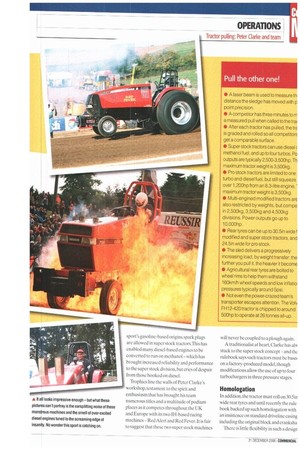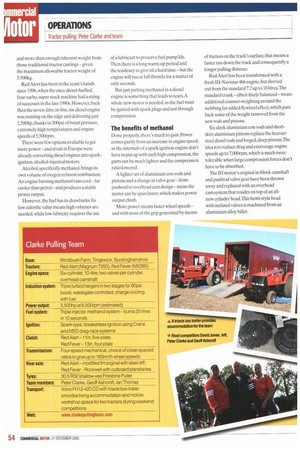Few grudge matches are as fearsome as those in tractor
Page 52

Page 53

Page 54

Page 55

If you've noticed an error in this article please click here to report it so we can fix it.
pulling — where multi-engined tractors packing up to 10,000hp battle for supremacy. But for dairy farmer Peter Clarke and his team, a 3,500hp, 10-litre engine is more than enough to secure any number of podium finishes. Team-mate Geoff Ashcroft reports.
For Buckinghamshire dairy farmer Peter Clarke,the tractor-pulling bug took hold almost 30 years ago when the US-based sport surfaced in the UK.
Things were relatively straightforward back then; the farm's Fordson Major was turbocharged and its fuel pump tweaked to give a useful hike in power for competition, while keeping the vehicle reliable for farm work.
But as with any sport, tractor pulling has progressed and the standard has increased considerably. Moving that weight-transfer sled as far as possible along a 100m track requires an esoteric mix of speed, power and traction — it is crucial to get moving as quickly as possible, then keep the sled in motion to help counter the increase in load as the sled alters from being a rolling weight to a dead weight load in excess of 100 tonnes (see panel).
Force to be reckoned with
Despite such a load, it is common for a tractor to complete its run in a little under 10 seconds. But doing so requires power—and lots of it.
Aero engines, turbines, large-capacity industrial engines and trusty old V8s— you'll and them all at a tractor pull, bought or built to suit all depths of pocket.
Apart from these extensively modified machines, there are also two specific classes: pro stock and super stock.
Pro stock tractors are allowed just one turbo — super stock tractors can use up to four. And while a 300hp tractor once ruled the roost, now 3,500hp is necessary to make a difference — particularly in the super stock division,whert Clarke's team (the'Clarke Pulling Team') is one of the most successful in Europe. But there is an added twist. Because of the sport's gasoline-based origins, spark plugs are allowed in super stock tractors. This has enabled many diesel-based engines to be converted to run on methanolwhich has brought increased reliability and performance to the super stock division, but cries of despair from those hooked on diesel.
Trophies line the walls of Peter Clarke's workshop, testament to the spirit and enthusiasm that has brought his team numerous titles and a multitude of podium places as it competes throughout the UK and Europe with its two IH-based racing machines Red Alert and Red Fever. It is fair to suggest that these two super stock machines will never be coupled to a plough again.
A traditionalist at heart, Clarke has alv stuck to the super stock concept and tht rulebook says such tractors must be base( on a factory-produced model, though modifications allow the use of up to four turbochargers in three pressure stages.
Homologation In addition, the tractor must roll on 30.5in wide rear tyres and until recently the rule book backed up such homologation with an insistence on standard driveline casing including the original block and cranksha There is little flexibility in such a design and more than enough inherent weight from those traditional tractor castings given the maximum allowable tractor weight of 3,500kg.
Red Alert has been in the team's hands since 1996, when the once diesel-fuelled, four-turbo,super stock machine had a string of successes in the late 1990s. However, back then the seven-litre, in-line, six-diesel engine was running on the edge and delivering just 2,500hp, thanks to 300psi of boost pressure. extremely high temperatures and engine speeds of 5,500rpm.
There were few options available to get more power and rivals in Europe were already converting diesel engines into sparkignition, alcohol-injected motors.
Alcohol, specifically methanol.brings its own volume of oxygen to boost combustion. An engine burning methanol runs cool far cooler than petroland produces a stable power output.
However, the fuel has its drawbacks. Its low calorific value means high volumes are needed, while low lubricity requires the use of a lubricant to preserve fuel pump life. Then there is a long warm-up period and the tendency to give oil a hard time but the engine will run at full throttle for a matter of only seconds.
But just putting methanol in a diesel engine is something that leads to tears.A whole new motor is needed, as the fuel must be ignited with spark plugs and not through compression.
The benefits of methanol Done properly, there's much to gain. Power comes partly from an increase in engine speed: as the internals of a spark ignition engine don't have to put up with such high compression, the parts can be much lighter and the compression ratio lowered.
A lighter set of aluminium con-rods and pistons and a change in valve gear from pushrod to overhead cam design mean the motor can be spun faster, which makes power output climb.
More power means faster wheel speeds and with most of the grip generated by means of friction on the track's surface, that means a faster run down the track and consequently a longer pulling distance.
Red Alert has been transformed with a fresh IH-Navistar 466 engine, but sleeved out from the standard 7.2 up to 10 litres.The standard crank -albeit finely balanced wears additional counter-weighting around the webbing for added flywheel effect, which puts back some of the weight removed from the new rods and pistons.
Six sleek aluminium con-rods and shortskirt aluminium pistons replace the heavier steel diesel rods and forged,deep pistons.The idea is to reduce drag and encourage engine speeds up to 7,000rpm, which is much more tolerable when large compression forces don't have to be absorbed.
The Hi motor's original in-block camshaft and pushrod valve gear have been thrown away and replaced with an overhead cam system that resides on top of an allnew cylinder head.This hemi-style head with inclined valves is machined from an aluminium alloy billet. Each combustion chamber gets a single spark plug, while airflow is assisted by titanium valves large enough to serve your dinner on.
The block runs dry, as methanol absorbs heat when it is burned, leaving the oil to fulfil a cooling and lubricating function. Given that the fuel is hosed into the engine along with air from three colossal turbos that produce around 80psi of boost pressure, the valve gear and pistons are almost washed cool.
Fuel is delivered through three injectors per cylindertwo of which are boost-controlled and simply return fuel to the tank until turbo pressure starts to climb.With more air comes more fuel, metered progressively, to allow the 10-litre engine to slurp its way through 25 litres of methanol in 10 seconds or 33 gallons per minute in old money, equivalent to 88 gallons per mile.
Lighting the fuel-and-air mix is a potent drag-race ignition system, triggered by flying magnets on the crankshaft:There is no advance or retard, but an electronic rev limiter holds the 10-litre straight six back at 7,200rprn should a drive line fail. No EGR or AdBlue here -it's just straightforward mechanical metering.
All of which sees the 3.5-tonne tractor pack a power-to-weight ratio of 1,000hp per tonne.
Keeping tabs on the turbo boost, fuel pressures, individual exhaust temperatures and revs is a sophisticated data logger. A print-out from each run enables engine performance to be analysed and further tweaks to be made.
A five-plate slipper clutch lets power run through a twin countershaft four-speed gearbox, and out through a steel differential with roller bearings. No diff-lock here, as power will feed out evenly if internal friction is kept low.
Red Fever the team's second tractor runs a nearidentical engine, fuel and turbo system to Red Alert, but is wrapped in a space-frame tubular chassis, eliminating cast-iron transmissions and rear ends normally associated with conventional tractor production. But the standard IN engine and crankshaft remain.
In August 2003, Red Fever rolled out c the Clarke workshop after a period of ell months under construction, in preparatic the 2004 season.
Assembled from specialist componeni and aluminium parts, Red Fever is lighte than Red Alert -enabling more moveab weight to be distributed around the tract to get up to the 3,500kg maximum allow weight. More importantly, the chassis alk the tractor to twist and absorb its torque, keeps the rear wheels of the 3,500hp mac more firmly planted on the track.
Both machines have brought the team considerable success. Winning the Euroe circuit and European Championship eve in 1999 with Red Alert has been backed regular podium finishes.
The 2006 season saw one or both tract( on the podium at every UK and Europea event that the team attended. Proof, if it needed,of the team's determination to st the top of its game..
































































































































































































